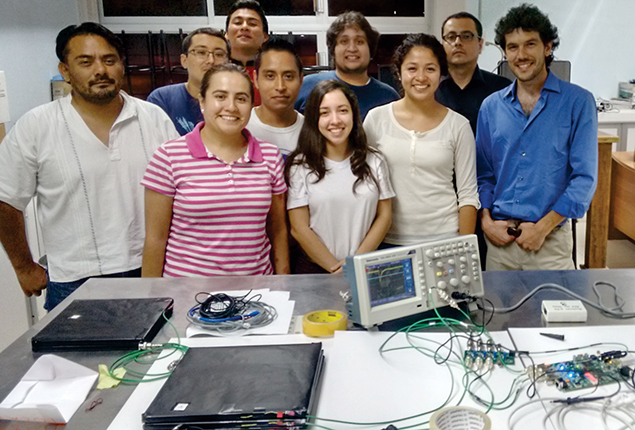A Fermilab envoy traverses Latin America
DOI: 10.1063/PT.3.3263
After spending three years as a graduate student at Fermilab, Federico Izraelevitch decided to take the long way home to his native Argentina—by van.
In addition to his wife and three dogs, Izraelevitch brought along 10 identical cosmic-ray detectors. He dropped off eight of them along the way, at universities in seven Latin American nations:

Escaramujo Project leader Federico Izraelevitch (right) poses with students from the Autonomous University of Chiapas in Mexico. The circuit board on the desk is a cosmic-ray detector made at Fermilab.
FEDERICO IZRAELEVITCH

Izraelevitch named his travels the Escaramujo Project, after the title of a song by Cuban folk singer Silvio Rodríguez, the theme of which is the right of all people to an education. Izraelevitch selected the universities by considering several factors, including their need for the hardware, the enthusiasm of their students, the route he planned to take, and his desire to avoid big cities. Because the detectors are identical, the approximately 80 undergraduate and graduate students he tutored will be able to share and analyze the data they collect.
Costing about $1600 apiece, the detectors were designed and assembled by Fermilab staff and a summer student, all of whom volunteered their time. Two companies donated components: SensL gave silicon photomultipliers, and Eljen Technology provided plastic scintillators. Fermilab covered the cost of data-acquisition electronics, he says, and provided “the inspiring environment, the great atmosphere, and the technical expertise of my colleagues.”
Izraelevitch had been in Argentina making detectors for use in nuclear medicine when he learned from a visiting scientist of opportunities to work with Fermilab researchers on experiments. Marcela Carena, the lab’s director of international relations, says probably a dozen Latin American students are working there at any given time (see the story on page 23
Izraelevitch is now back in his home country to complete his doctorate at the University of Buenos Aires. He says he hopes someday to return to Fermilab.
Although recruitment wasn’t the focus of his visits, Izraelevitch hopes that some of the students he inspired might end up working at Fermilab, which he calls “an amazing place to work.” He plans to deliver the remaining two detectors to universities in Brazil and Paraguay in the next year. When he does, he says, “I think it will be on an airplane.”
More about the Authors
David Kramer. dkramer@aip.org




